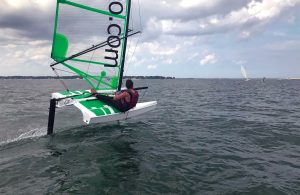
Long before any of you readers of this fine font were born, the Amaryllis II was whipping around Narraganset Bay on two pontoons because she was a sailing catamaran. She was experimental, elegant and I’d say completely outrageous for her time. Hunt up the video (there’s one in color!) and watch her pontoons go in different directions at plus twenty knots. She was speedy and that’s what this column is about: how this desk-slung gunslinger would propose amending the COLREGs to address the fast craft of today. The International Maritime Organization hasn’t acted so f’em as we’re ought to say around here.
First, add a category definition labeled “High Performance Craft.” Define HPC as a vessel capable of speeds in excess of 25 knots (maybe 20 knots or even a lower speed?) under sail or motor including, without limiting, vessels using hydrofoils.
Second, I’d take my pen to Rule 6 (Safe Speed) and I’d make it read something like this: “HPC shall at all times navigate at a speed that allows for safe avoidance maneuvering with consideration given to the limited reaction time and reduced visual conspicuity of such vessels.”
Third, with respect to Rule 7 (Risk of Collision) I’d pencil in language like this: “For HPC, the risk of collision must be evaluated at greater range due to high closure rates, and such vessels must presume others are not aware of their speed or direction.”
Fourth, I’d strap this language to Rule 8 (Action to Avoid Collision): “Avoidance maneuvers by HPC should be made early and significantly. Evasive action relying on the unique agility of such craft shall not substitute for standard precautions under these rules.”
And then on Rule 18 (Responsibilities Between Vessels), I’d include text like this: “The privilege of sail over power does not exempt HPC under sail from exercising extreme caution and early maneuvering when approaching vessels that may not reasonably detect their presence or understand their trajectory.”
Aside from wordsmithing, the COLREGs should be supplemented to require motorized HPCs install and energize an AIS Class B transponder while underway in inland waters or coastal waters. If dry-cell powered AIS units become available, then all HPCs (sail and power) should carry them. (I’ve looked and I can’t find any such dry-cell units on the market yet, but it’s time and I suspect a clever person with a Raspberry PI and some programming skills could design and build one.)
Similarly, I think all HPCs should be required to display a unique and highly visible lighting arrangement (a strobe or rapid-pulse beacon, maybe?) while operating in inland or coastal waters at night or in restricted visibility. You know, something bright that will have folks tootling along (cocktailing) in their Shields, Catalina or aboard their Grand Banks saying, “Whoa, that thing is moving quick!”
And then there’s the local authorities from harbor masters to the captains of the port. These folks should spend their winter months coming up with designated no-foil areas and speed-restricted corridors. They don’t have to go crazy reinventing navigation, but they need to lay down some boundaries.
Now against all this, it’ll sound strange for me to say that I don’t like rules. Never have – just look at my prep school transcripts! Still, I’ve made a living in a rule-bound setting where the course and outcome of a lawsuit is often determined by the applicable rules. In this way, I’ve come to appreciate the value of guard rails not only as limits, but as signals. Warnings of dangers ahead.
No, I don’t believe in the nanny state (or an overly regulated scheme a la the Europeans), but I do believe in rules that evolve with the world they govern. For instance, the Federal Rules of Civil Procedure are regularly amended and supplemented to add clarity, promote efficiency and address societal changes. As far as I can tell, the last substantive change to the COLREGs was 20-plus years ago! That’s crazy; nay, that’s complacency.
The Amaryllis flower is striking. I know it for its cheery evolution from bulb to bold burst of color around the holidays. I’ve read it traditionally signals pride, strength and determination. Maybe this holiday season I’ll post an Amarylis bulb to the south bank of the Thames where that big, bronze ship’s nose pokes out of the International Maritime Organization’s headquarters (the primary body responsible for proposing and adopting changs to the COLREGs). I’ll include a note; something simple and cheery like “Get off your arses and fix up these COLREGs!”
Underway and making way. ■
John K. Fulweiler, Esq. is a Proctor-in-Admiralty representing individuals and small businesses in maritime matters including personal injury claims throughout the East and Gulf Coasts and with his office in Newport, Rhode Island. He can be reached at 1-800-383-MAYDAY (6293) or john@saltwaterlaw.com, or visit his website at saltwaterlaw.com



